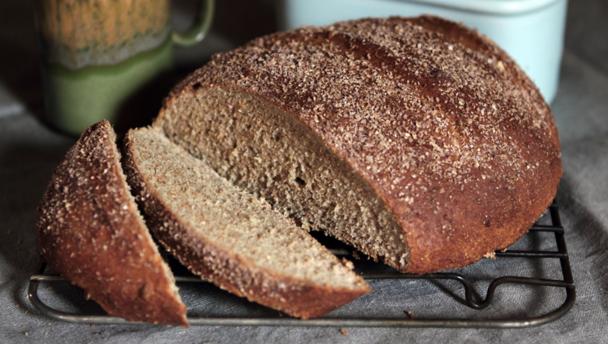Doris Grant loaf

Ingredients
- 225g/8oz strong white bread flour, plus extra for dusting
- 225g/8oz strong wholemeal flour
- 1 tsp salt
- 1 x 7g sachet fast-action dried yeast
- 1 tbsp clear honey
- 300ml/11fl oz warm water
- vegetable oil or oil spray, for oiling
- a little milk, for brushing
Method
-
Dust a medium baking tray well with flour.
-
Sift the flours and salt into a large bowl. Reserve a tablespoon of the grain – the brown bits that are too big to fit through the sieve. Stir the rest through the flour mixture. Stir in the yeast, then make a big hole in the centre and pour in the honey and most of the water. Mix well to form a smooth dough, working it gently with your hands if necessary. If the dough feels a bit stiff, add more of the water.
-
Shape the mixture into a ball and place on the prepared baking tray. Make sure the top is smooth and wrinkle-free. Cover the dough loosely with oiled clingfilm, making sure it is airtight, and leave to rise in a warm place for a good hour, or until it has almost doubled in size.
-
Preheat the oven to 200C/400F/Gas 6. Remove the clingfilm from the dough and make a few slashes in the top with a sharp knife – I use a sharp, serrated knife and saw gently. Brush the loaf with milk, sprinkle with the reserved grain and then place in the oven.
-
Put about 10 ice cubes into the bottom of the oven – they will produce steam, which keeps the crust from hardening too quickly. (A quickly hardened crust prevents the bread from rising well.) Bake the bread for 30–40 minutes, or until it has risen, sounds hollow when tapped underneath and comes easily off the baking tray. Remove from the oven and leave to cool on the tray.
-
Serve fresh from the oven with loads of butter. These loaves do not keep well. However, if the whole lot does not disappear in one sitting, slice up the remainder and put it in the freezer to eat as toast.